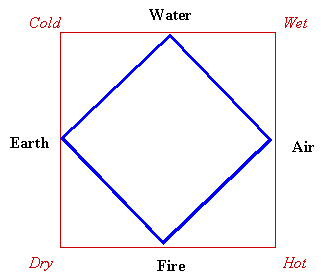
Program Notes: 10/26/01
Science Lecture: History of Chemistry and the Development of Modern Atomic Theory
Introduction -
Chemistry: the study of matter and the changes it undergoes.
Matter: anything that has mass and occupies
space.
What is the nature of matter? Do atoms
exist? Why do you believe so? What evidence do you have?
Historical Origins of Chemical Technology-
Earliest use of chemicals: ~30,000 BCE, plant dyes from plant and animal materials; cave paintings
Earliest use of pottery: ~18,000 BCE, used for small sculptures
Earliest use of metal: gold, silver ~9000 BCE
Gold and silver were first used because they are the only two metals that are found in the metallic state, not as an ore (such as iron or aluminum ore); metals possess very unique properties (e.g., they are malleable) compared to previously known materials such as stone, wood or bone. Due to scarcity of gold, it became a prized status symbol.Earliest refinement of copper: ~5000 BCE
early kilns found in Sinai desert- copper was stronger than other metals previously used. Copper became used for tools and materials. The mineral malachite, a form of Cu(CO3), a deep green material, was placed in a charcoal fire (in which carbon monoxide was present) and reacted chemically to yield metallic copper. The reaction is:Earliest use of soap: ~3000 BCE, made from tallow (animal fat) and ashes; by Sumarians (part of Babylon)Cu(CO3) + CO ® Cu + 2 CO2
Earliest beer brewed: ~3000 BCE, first appearance of barley, grains, crops, hops; Babylonians, "Fertile Crescent"
Earliest bronze: ~3000 BCE. Bronze is an alloy (a mixture) of copper and tin; much harder and more durable than pure copper or pure tin; marked the beginning of the Bronze Age.
Earliest iron: ~2,500 BCE. Much harder and stronger than bronze, it made for better tools and weapons; first produced by the Hittites, who quickly rose to prominance in what is now Turkey; Hittite empire fell in about 1,200 BCE and the technology of iron refinement quickly spread and began the Iron Age.
First Permanent dyes: ~1000 bce. Tyrian purple, made from shellfish; ~20,000 shellfish required to dye 1 square yd.of fabric. Formelry most dyes would wear out after time; Tyrian purple was long-lasting; became religious/status symbol due to its high cost.
Greek Natural Philosophy -
Beginning of scientific philosophy: ~500-300 BCE, Greek Natural Philosophy. This was the first time there was a social structure that created a "leisure" class; people were able to speculate the nature of the universe.
Two schools of thought concerning the nature of matter:
Aristotle:Matter is continuous - that is, no "smallest particle" exists; it is infinitely divisible.
Matter consists of "Prime Matter"; 4 qualities of prime matter: dry, hot, wet, cold
4 elements associated with the 4 qualities: water, earth, air, fire.

Chemical changes occurred when the proportion of the 4 elements change. For example, when water froze, food rotted, organisms grew, etc.
Democuritus/Epicurus: opposed to AristotleBelieved that matter exists as atoms - tiny, indivisible particle of matter (the word atom comes from the Greek word for indivisible). Differences in physical properties shaped by differences in shapes and sizes of the atoms (e.g., fire atoms were thought to be pointy, water atoms round, iron atoms "corkscrew" shaped).
Proposed that atoms were in constant random motion. The idea that atomic motion was random, that is not controlled by anything, was heretical. In addition, the atomic theory failed to explain many observed phenomena - Greek atomic theory was abandoned.
Aristotle's "continuous" view of matter persisted for abour 2,000 years.
Alchemy and the Rise of Chemistry
After the fall of Rome, little development of chemical technology was done in Europe until alchemy was introduced, (~1000 CE) from the Arab World.
Alchemy had two goals:
1) turn "base" metals (lead, iron, tin) into gold.Alchemy was banned in the 1300s, and alchemists were often persecuted for heresy, etc.
2) search for immortality, the "elixir of life".
Alchemy started to die during the "enlightenment period"; it is considered a forerunner to chemistry.
~1600 CE marked the rise of the "atomists"- those who turned to atomic theory as an explanation of the nature of matter; partially prompted by the publication of Lucretius' "On the Nature of Things".
Several problems in Aristotle’s theory became apparent.
- fire is not an elementBirth of Modern Chemistry
- vacuums exist, despite Aristotle's belief otherwise (no fire can exist in a vacuum; therefore fire is not an element.)
- idea of transmutation (the "growth" of minerals into precious metals) was demonstrated to be invalid.
Antoine LeVoisier (1743-1794) - "The Founder of Modern Chemistry"
Can You See Atoms? Not using light. But Scanning Tunneling Microscopy can generate images of individual atoms. It is also possible to place atoms with great precision in specific locations. (see links for some nice images)